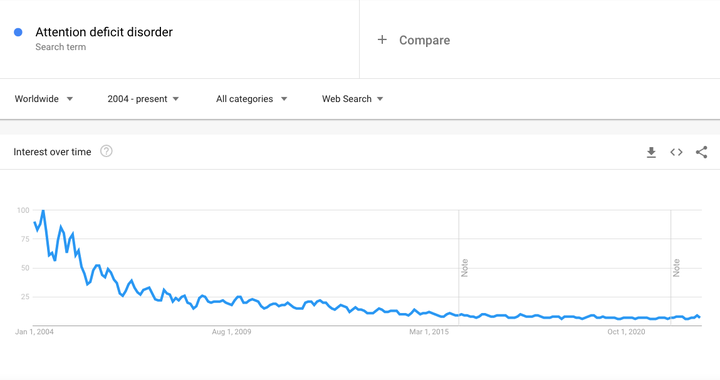These days, you’re more likely to hear the term ADHD than ADD when talking about the health condition. Experts explain why.
When I was younger, I often heard people say things like “I’m so ADD right now!” to refer to periods when they had trouble focusing. Others would talk about “ADD meds,” like Adderall or Ritalin. Invoking ADD, or attention-deficit disorder, felt rather common in the ’90s and early aughts.
The term was also used interchangeably with ADHD, or attention-deficit/hyperactivity disorder. These days, however, I find people tend to stick to ADHD when describing the condition.
Why don’t we say ADD anymore, and it’s been changed to only saying ADHD? My cursory Google search only tells me that we changed, not why.
— Bronwyn Harris, One Outspoken Educator (@BronwynAnn) September 28, 2022
It turns out it’s not just a cultural shift. There are scientific reasons behind the change.
“The terms for what is now known as ADHD have been going through an evolution with nearly every new edition of the Diagnostic and Statistical Manual, or the ‘DSM,’” said Billy Roberts, a therapist at Focused Mind ADHD Counseling in Columbus, Ohio. “Diagnoses are often updated to reflect our improved understanding of a condition and the most up-to-date research.”
The DSM is the go-to manual for psychological diagnoses and has changed considerably since the first edition was published in 1952. The evolution of ADHD and ADD in the DSM goes back to the 1960s.
“ADHD originally was named ‘hyperkinetic reaction of childhood’ in the 1968 second edition of the DSM,” explained Cristina Louk, a clinical psychologist based in Washington state. “Disorders will often get name changes when research uncovers more about the condition.”
Researchers throughout the ’50s and ’60s used terms like “hyperkinetic reaction of childhood,” “hyperactive child syndrome,” “hyperkinetic-impulse disorder” and even “minimal brain dysfunction” to describe what we know now as ADHD. In the ’70s and early ’80s, the name shifted closer to today’s version.
“The term attention-deficit disorder or ‘ADD’ first appeared in the third edition of the DSM in 1980,” said J. Russell Ramsay, co-founder and co-director of the University of Pennsylvania’s adult ADHD treatment and research program. “Subtypes were designated as either ‘with hyperactivity’ or ‘without hyperactivity.’”
Seven years after the DSM-III was released came the DSM-IV, which included another label revision.
“In 1987, ADHD got its final name when the fourth edition of the DSM was published,” Louk said. “The two types were broadened into three: ‘inattentive type,’ ‘hyperactive/impulsive type,’ and ‘combined type.’ In the current rendition of the DSM (DSM-5), the name has remained the same, but the ‘types’ were changed to ‘presentations’ and noted that these presentations are more fluid and can fluctuate over time.”
Basically, ADHD was called ADD until 1987 when the name was officially changed from attention-deficit disorder to attention-deficit/hyperactivity disorder. Although clinicians previously categorized ADHD into three separate types, there’s been a more recent shift to simply consider which symptoms present more prominently, which can change throughout an individual’s life.
“Ultimately, the diagnosis was changed to better reflect the fluid nature of symptoms across the lifespan,” Roberts said. “For example, although someone might continue to meet criteria for ADHD, the subtype of ADHD they demonstrate might change in adulthood. This means that a child might have ADHD, combined type, but by adulthood meets criteria for only inattentive type.”
The symptoms of ADHD can vary by age and from person to person, but there are many common signs. Hyperactive and impulsive symptoms include fidgeting, feeling restless, being prone to outbursts, interrupting others and talking excessively.
On the inattentive side of things, you might have trouble paying attention and maintaining it during various tasks and activities. You may be easily distracted or forgetful, overlook details, fail to listen and follow though, procrastinate and avoid tasks that require sustained mental effort. If you’ve experienced multiple ADHD symptoms over a long period of time, you might want to seek a professional evaluation.
As for the term ADD, it has slowly become outdated. Google Trends data shows a decline in search interest for “attention deficit disorder” over the past 18 years.

“ADD is essentially synonymous with ADHD, inattentive type,” said Los Angeles-based therapist Rachael Bloom. “While this was recognized in the clinically a while ago, I think it takes longer to catch on in mainstream language.”
Meanwhile, searches for “attention deficit hyperactivity disorder” remained more steady and even increased over the past two decades. Psychotherapist and ADHD coach Terry Matlen believes this is consistent with her anecdotal observations as well.
“The two terms are used interchangeably, still, though I have noticed that more people, particularly clinicians, are using the more current term of ADHD.”
The experts HuffPost spoke to generally approved of the shift toward using the clinically accurate ADHD. Although there is still a sense of stigma around the disorder, use of the term ADHD seems to mark a positive step away from previously common phrases like “you’re so ADD!” which were often used in a derogatory manner.
Give it a couple more decades and perhaps younger generations will be as familiar with “ADD” as we are with “hyperkinetic reaction of childhood.”
Credit: Source link